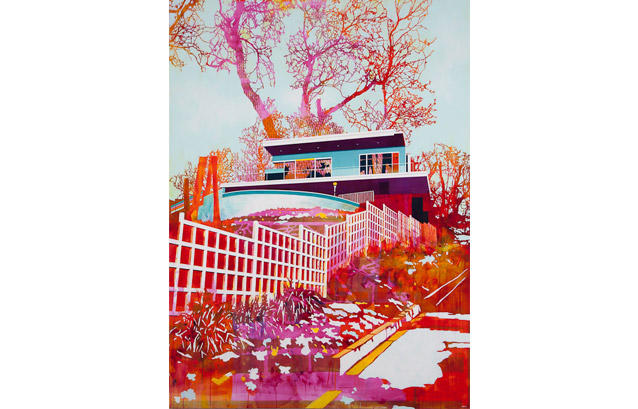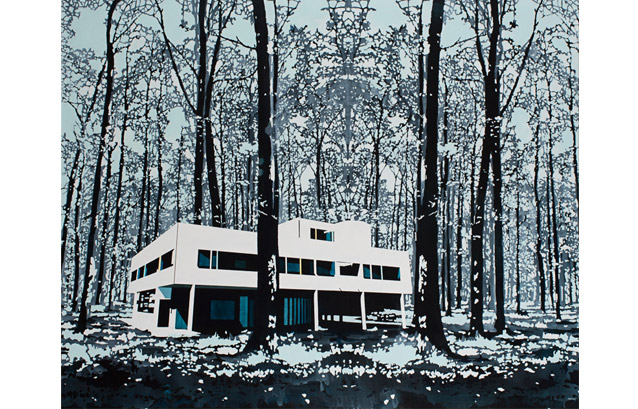But, in Davies’ house, there is no one home. The front door is shut, the house is empty, and the windows dark. And with no-body to swim in it, the pool is now an untouched mirror for the blackened and vacant form above it. Suddenly, with eerie precision, this is no longer a home we recognize, but an isolated landscape where we are the lone figure.
“I’d seen these buildings photographed before,” says Davies of his modernist house, “and they seem inviting.”

“But when you are actually there,” he continues, “when you are confronted with their concrete, and their form, you feel abandoned and isolated – there is a kind of eerie nature about them.” With their ghostly flowing curtains, iridescent pink skies and lurid bush surroundings, Davies’ artworks certainly portray this certain kind of eerie.
Davies in fact doesn’t paint homes, rather he portrays objects: spaces that anyone, anywhere, can inhabit. “These buildings are meant to be ambiguous,” he comments, “I want to invite the viewer to create their own interpretations, I want them to think about the building.”

And although Davies’ latest exhibition, Flattening Sublime, finds inspiration from the great European architectural works he photographed during his residency at the Cite Internationale des Arts in Paris, his artworks still retain a certain degree of ambiguity – they are at once both recognisable and somehow foreign. “It might be a French manor that I paint, but it is by no means the Eiffel Tower – my paintings are not as specific as that,” he explains.
It is therefore not the iconic modernist form itself that inspires Davies. Rather, like good architectural practice, it is a building’s relationship to the places and people around it that fuels his’ passion. “I use those weird, ‘creepy’, pastel colours to provide important contrasts in my works,” he syas, “If the entire piece was all dark, then you would essentially see the same thing twice. This way you are held at a distance from the form, and therefore are forced to reflect on it and its surroundings.”

Constructing landscapes that collide in highly unexpected and mesmerizing ways, Davies’ artworks reveal both the beauty and brutality of modernist architecture in ways that, in the end, are quintessentially Australian. Much like the works of Howard Arkley, Davies has found a truly unique perspective to reflect upon these great European forms on a flat, 2D canvas.
And perhaps the success of this lies in the very meaning and structure of the houses themselves. For, as Frank Lloyd Wright once said, “the space within becomes the reality of the building.” But within Davies’ building, the space is empty, and therefore the reality becomes the viewer’s.

Image courtesy of Matt Reed: reedphotography.com.au
Paul Davies’ next exhibition is Natural Selection at the Fine Art Society – Contemporary, London, opening 19th July.
faslondon.com

